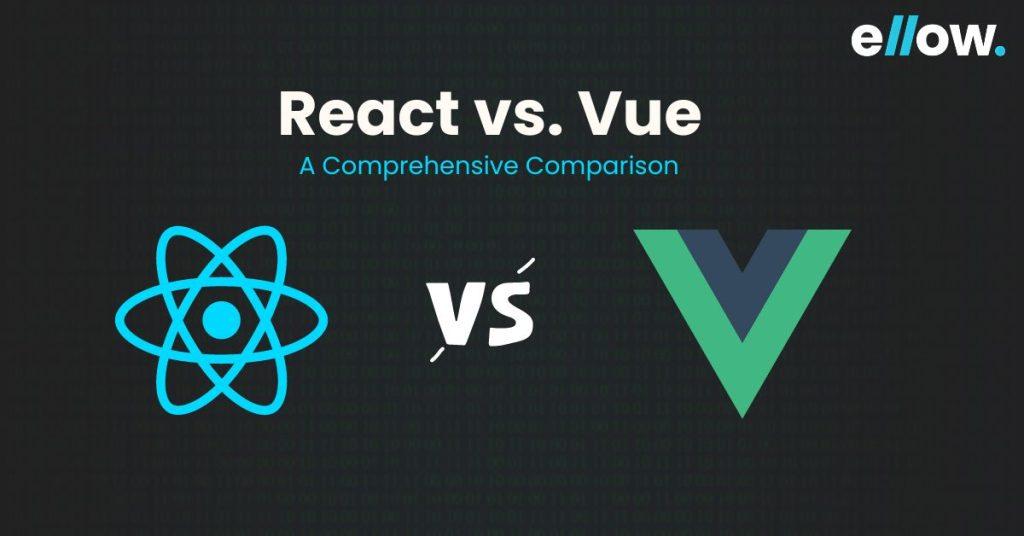Do you need help with React and Vue for your next web development project? Choosing the right front-end framework is key to building a dynamic and competitive online presence. React and Vue are both top contenders, each bringing unique strengths to the table.
A recent Statista survey highlights React and Vue are among the most popular web frameworks globally. But how do you decide which one is right for you? Understanding their differences and advantages can make all the difference in your project’s success.
This article will dive into a head-to-head comparison of React and Vue. We will explore their features, benefits, and potential drawbacks to help you make an informed decision. Whether you are a seasoned developer or just starting, this analysis will provide valuable insights to guide your choice.
Understanding React
React is often mistaken for a JavaScript framework, but it is an open-source JavaScript library. Developed by Facebook in 2011, React is used to create user interfaces for web applications. React quickly became a leading technology in frontend development, challenging the dominance of Angular, Backbone.js, and jQuery.
Here are some key statistics about React:
- React has over 1,644 contributors on GitHub and has received more than 216,000 stars.
- According to the 2023 StackOverflow survey, React.js was the most popular frontend web technology with 42.87% of votes.
Types of Frontend Web Apps Built with React
React.js is versatile and can be used to develop various types of applications, including:
- Single Page Applications (SPAs)
- Media sites
- Video streaming platforms
- SaaS solutions
- Content Management Systems (CMS)
- Progressive Web Apps (PWA)
- Interactive dashboards
- E-commerce websites
- Educational apps
- Travel booking apps
- Desktop apps
- Mobile apps
Major Brands Using React.js
Many well-known companies have adopted React.js for their app development:
- Facebook: Utilizes over 20,000 React components in its web app, particularly for the Facebook Ads Manager.
- Walmart: Employs React to ensure platform consistency and enhance user experience.
- Netflix: Uses React for optimized startup speed and runtime performance.
- Airbnb: Developed a cross-platform app with React for consistent performance across all operating systems.
- Twitter: Uses React to enhance the UI of its web app, especially in the Tweet compose box and timeline.
Other notable brands using React include Grammarly, BBC News, Pinterest, Myntra, Uber, and Lyft.
Advantages of React
React offers several benefits for web app development:
- Simplicity: React has a well-defined lifecycle and a component-based approach, making it straightforward to use. It employs JSX, which combines JavaScript and HTML.
- Dynamic Web Apps: React uses JSX to support HTML quotes and syntax, enabling the development of dynamic web applications.
- Reusable Components: React’s component-based structure allows for reusable and maintainable code.
- Optimized Performance: React uses a virtual DOM, which enhances performance by updating only the necessary parts of the app.
- Large Community: With a large community of over 14.7 million developers, React provides extensive support and continuous improvements.
- SEO-Friendly: React can work on the server side and render on the browser as a regular web page, improving SEO.
Disadvantages of React
Despite its many advantages, React has some limitations:
- Library, Not Framework: As a library, React’s flexibility can sometimes lead to code uniformity issues and difficulties for new developers.
- Complex Syntax: React’s JSX syntax can be challenging for beginners.
- Frequent Updates: React undergoes frequent updates, requiring developers to stay up-to-date with changes.
- UI Focus: React only handles the view layer of an application, necessitating the use of other technologies for a full-stack solution.
Understanding both the strengths and weaknesses of React can help in making an informed decision when choosing between React and other technologies like Vue.js for your project.
Understanding Vue.js
Vue.js is an open-source JavaScript framework for building user interfaces and single-page applications (SPAs). It is known for its simplicity, flexibility, and high performance, making it a popular choice among developers.
Here are some key statistics about React:
- The Vue.js subreddit on Reddit has over 99k members, placing it in the top 5% of all communities by size.
- According to BuiltWith, more than 1,689,786 live websites currently use Vue.js.
Types of Web Applications Built with Vue.js
- Single-Page Applications (SPAs): Vue.js is ideal for creating SPAs due to its efficient data binding and component-based architecture.
- Progressive Web Apps (PWAs): Vue.js supports the development of PWAs, which provide a native app-like experience.
- E-commerce Sites: Its reactive components and seamless user experience make Vue.js a good fit for e-commerce platforms.
- Content Management Systems (CMS): Vue.js can be used to build dynamic and user-friendly CMS solutions.
- Real-Time Applications: Vue.js is suitable for applications that require real-time updates, like chat apps and live dashboards.
Major Companies Using Vue.js
- Adobe Portfolio: Utilizes Vue.js to enhance the front-end performance and optimize the user experience.
- Trivago: Uses Vue.js and Nuxt.js to power its Trivago Magazine subsite, improving SEO and user engagement.
- Behance: Migrated its entire codebase to Vue.js to achieve better performance and maintainability.
- GitLab: Adopted Vue.js to simplify the management of complex features and improve code scalability.
- Upwork: Transitioned from AngularJS to Vue.js for a more efficient and flexible front-end development process.
Advantages of Using Vue.js
- Simplicity: Vue.js features a single-file component architecture, making it easy to understand, test, and debug.
- Lightweight: The framework is around 20 KB, ensuring quick download and installation without taking up much space.
- Comprehensive Tooling: Vue.js offers robust tools like Vue CLI for project scaffolding and development.
- Flexibility: It allows incremental integration, making it suitable for both small parts of an application and full-scale projects.
- Compatibility: Vue.js integrates well with other front-end frameworks like Angular and React, facilitating seamless collaboration.
Disadvantages of Vue.js
- Frequent Updates: The rapid release cycle can be overwhelming for developers, especially beginners.
- Language Barrier: Much of Vue.js’s documentation originates from China, leading to potential translation issues.
- Limited Expertise: As a relatively new framework, finding experienced Vue.js developers can be challenging.
- Fewer Plugins: Compared to other frameworks, Vue.js has a smaller ecosystem of plugins, which might limit its functionality.
- Mobile Compatibility: Apps built with Vue.js sometimes face issues with older mobile browsers.
These points offer a comprehensive view of Vue.js, highlighting its strengths and limitations for developers considering it for their next project.
React vs Vue: Key Similarities
- JavaScript Foundation
Both React and Vue are grounded in JavaScript, leveraging its power to build robust and dynamic web applications.
- Dynamic User Interface Creation
Both React and Vue support virtual DOM and encourage a declarative approach to constructing UI components, making them ideal for creating highly interactive user interfaces.
- Thriving Open-Source Communities
Both frameworks are open-source, fostering vibrant communities of developers who continuously enhance their capabilities through third-party plugins, APIs, and libraries.
- Progressive Web App (PWA) Capabilities
Both React and Vue enable the development of Progressive Web Apps, offering users native-like experiences such as push notifications and offline capabilities, enhancing accessibility across various devices.
- Facilitate Rapid Development
Due to their component-based architecture, React and Vue streamline app development processes. React emphasizes clear router system selection and managing complexities, while Vue integrates seamlessly with tools like Vue dev-tools and StoryBook, promoting swift and creative application development.
React vs Vue: Key Differences
- Support for App Architecture
React provides support mainly for the view layer of an application with a component-based architecture. To build complete applications, developers often rely on additional libraries like Redux and MobX. Vue, on the other hand, uses the Model-View-ViewModel (MVVM) architecture, offering more built-in structure for large-scale applications.
- Ease of Learning
React has a moderate learning curve, partly due to its use of JSX, a syntax extension that allows HTML with JavaScript. Vue is generally easier to learn, especially for beginners, thanks to its simpler and more intuitive syntax.
- Support for Complex App Development
Is React suitable for complex projects? Yes, React is excellent for complex projects, particularly single-page applications that require server-side rendering and responsive UIs. Its ecosystem includes tools like Next.js for server-side rendering.
Is Vue suitable for large applications? Vue is also good for complex apps, using its state management library Vuex to handle large-scale applications efficiently without requiring extensive external libraries.
- User Interface (UI) Experience
Both React and Vue offer excellent user experiences with support for virtual DOM and efficient rendering. React is often preferred for its robust UI components, while Vue’s two-way data binding makes it easier to manage and experiment with UI changes.
- Application Size
Vue is generally lighter than React, with app sizes typically ranging between 50KB to 100 KB. React apps tend to be larger but have seen improvements in reducing package sizes in recent versions.
- Application Performance
Are React apps fast? Yes, React apps are known for their high performance, thanks to features like virtual DOM and component reusability, which minimize DOM manipulation and improve efficiency.
- Scalability
Both React and Vue support scalable application development. React’s JavaScript-based structure and extensive ecosystem make it well-suited for large-scale projects. Vue’s component-based architecture and tools like Vuex and web packs also support scalable development.
- Flexibility
React offers greater flexibility by allowing the integration of various third-party components. Vue provides a set of built-in components but is considered less flexible than React, which can lead to more complex code management.
- Code Maintainability
Both frameworks support maintainable code through their component-based architectures. React’s extensive community and resources give it an edge in terms of support and best practices for code maintainability.
- Mobile App Development
React Native allows React to be used for building native-like cross-platform mobile apps. Vue, with its collaboration with NativeScript, also supports mobile app development, but React Native is generally more robust and widely adopted.
- Security
Both React and Vue have vulnerabilities, but they can be mitigated with best practices and external libraries. React is prone to attacks like XSS and SQL injections, while Vue includes built-in sanitizers to help secure applications.
- Testing Support
React has strong testing support with tools like Jest and Mocha, which streamline the testing process and improve time-to-market. Vue also supports testing with tools like Vue Testing Library and Vue Test Utils but is still evolving in this area.
Check this video out: Vue vs React (2024) – Make a RIGHT Choice (Difference Explained)
This table provides a comprehensive comparison of React and Vue across various factors, making it easier to understand the key differences and choose the right framework based on specific project needs.
| Factor | React | Vue |
| Developer | Evan You | |
| First Release | 2013 | 2014 |
| Language | JavaScript | JavaScript |
| Type | Library | Framework |
| Architecture | MVC (Model-View-Controller) | MVVM (Model-View-ViewModel) |
| Data Binding | One-way | Two-way |
| DOM | Virtual DOM | Virtual DOM |
| Syntax | JSX | HTML, JSX |
| Learning Curve | Medium | Easy |
| Coding Speed | Normal | Fast |
| Rendering | Server-side | Server-side |
| Scalability | Highly scalable | Moderately scalable |
| Component Structure | Component-based | Component-based |
| State Management | Depends on external libraries (Redux, etc.) | Built-in state management (Vuex) |
| Community and Documentation | Large community, extensive documentation | Growing community, good documentation |
| Tooling and Ecosystem | Extensive tools and plugins | Adequate tools and plugins |
| Complex App Development | Suitable for complex apps | Suitable for complex apps with Vuex |
| User Interface (UI) Experience | Rich UI components, responsive UIs | Easy experimentation with UI changes |
| App Size | Generally larger, but improving | Lightweight (50KB – 100KB) |
| App Performance | High performance, efficient rendering | High performance, efficient rendering |
| Scalability | Highly scalable with extensive tools | Scalable with component-based architecture |
| Flexibility | Highly flexible with third-party components | Moderate flexibility, fewer built-in components |
| Code Maintainability | Easy with community support | Easy but less community support |
| Mobile App Development | React Native for cross-platform apps | NativeScript with Vue for cross-platform apps |
| Security | Prone to XSS and SQL injections | Built-in sanitizers for better security |
| Testing Support | Strong support with Jest, Mocha | Evolving support with Vue Testing Library |
| Popularity | A more popular, larger community | Growing popularity, smaller community |
| Performance | Fast with features like virtual DOM | Fast with features like virtual DOM and lazy loading |
| Ease of Integration | Easy integration with other libraries | Easy integration with other libraries |
| Customization | The high degree of customization | Moderate customization |
| Documentation Quality | Extensive and detailed | Good, but still evolving |
| Employment Opportunities | Higher due to wider adoption | Growing, but fewer compared to React |
Choosing Between Vue and React: Which Should You Pick?
Vue and React are powerful JavaScript frameworks, each with strengths and ideal use cases. To determine which is best for you, consider your needs and project requirements.
When to Choose Vue?
- Small Projects: Vue is perfect for smaller projects that need quick development and easy learning.
- Progressive Web Apps: Vue is a solid choice if you’re focusing on building progressive web apps or single-page applications.
- Enhancing Existing Apps: Vue is great for scaling and adding functionalities to existing applications.
When to Choose React?
Extensive Tooling and Libraries: React offers a vast ecosystem of tools and libraries, making it ideal for projects that require a wide range of functionalities.
- Complex, Large-Scale Apps: For large applications with high complexity and tight deadlines, React provides robust solutions.
- High Responsiveness: React is excellent for creating apps with beautiful, responsive components.
By understanding the strengths of each framework, you can make an informed decision that aligns with your project’s goals.
Conclusion
Choosing between React and Vue depends on various factors, including your project’s needs, the features of each framework, and the availability of developers skilled in each. It is crucial to focus on which framework best fits your project requirements rather than getting overwhelmed by online resources. Other considerations, such as the complexity and size of your project, can also influence your decision.
Both React and Vue have their strengths and weaknesses, and the expertise of your developers will significantly impact your choice. Connect with ellow.io for hiring React and Vue developers for your project needs.
FAQs
- Which is easier to learn, React or Vue?
Vue is generally considered easier to learn for beginners due to its simpler syntax and more straightforward documentation. React, while powerful, often requires understanding additional tools and libraries to be fully effective.
- Is React more popular than Vue?
Yes, React is currently more popular than Vue. It has a larger community, more job opportunities, and widespread use in large-scale applications and by major companies.
- Can I use React and Vue together in a project?
While it’s possible to use both frameworks in a single project, it’s not common practice and can lead to increased complexity. Typically, projects choose one framework to avoid potential conflicts and redundancy.
- Which framework offers better performance, React or Vue?
Both React and Vue offer excellent performance, but their efficiency can depend on how they’re implemented. React’s virtual DOM and Vue’s reactivity system are both designed to optimize rendering performance.
- What are the main use cases for React and Vue?
React is often used for building complex, large-scale applications with high performance and dynamic user interfaces. Vue is typically preferred for smaller to medium-sized projects, as well as for adding interactivity to existing applications due to its simplicity and ease of integration.









